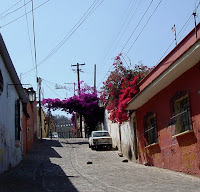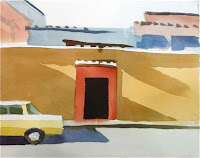Greetings, painters
Please read through this article, then look for a photo that presents a wide range of values, from very light to very dark. Try your hand at the process described here. If you have time, and are inclined, see how what the value study teaches you informs a color version.
Five Value Monochrome Study
What role does value play in the relationships between the big shapes?
As a first treatment of a new subject, it would be hard to find a better exercise than a value study. Understanding the dark/light relationships between the big shapes in your composition is an essential step to making a painting that is cohesive. A five-value version (white, light grey, middle grey, dark grey, black) can be done quite quickly over a simple drawing of the big shapes. It also provides good practice for seeing in layers. Choose a color (just one) straight from the tube, that can get dark enough to represent black. It’s better not to make a color by mixing, since that introduces another variable. This exercise is designed to focus on value only. Similarly, all paint should be applied to dry paper, to keep wetness from distracting your attention from value.
If you are tempted to get fussy about edge quality, or texture, or any kind of detail, remember, this is NOT A PAINTING, and it is supposed to be too simple. A door may be important, but the doorknob probably isn’t. I have seen some so-called value studies that are, in fact, very carefully observed monochrome paintings. They may be quite beautiful, but as tools designed to reveal the essential elements of the scene, they are not very useful. The best way to find out if something needs to be in the picture is to leave it out.
After each step, while you’re waiting for the paper to dry, assess how complete the illusion of light and space and substance feels.
Light is an important component of this image. Isolating the variable of Value should reveal the role it plays in creating the illusion of sun and shadow.
In your drawing of the big shapes, try to keep the number down to ten, or fewer. The profile of each shape is all you need to draw. The idea is to locate the shapes, not to describe them.
· Starting with the light grey, paint the entire page, except for any shapes that need to stay white.
Is there a feeling of light in the study? What about space? Substance?
· When that layer is dry, paint the whole page middle grey, except for the lights and the whites. If you can’t decide whether a shape should be light or middle, round it off one way or the other. The finished study will reveal whether you made the right choice.
Again assess the state of the illusion: Light? Space? Substance?
· When layer two is dry, apply the dark grey over everything except the middle, light and white shapes. Now that the background figure has a dark grey layer, and the section of wall behind him does not, notice how effectively the two separate, compared to the previous stage.
Finally, paint in the darkest darks.
The role of the darkest darks in creating an illusion of light, space and substance is clear even in a radically over-simplified image.
Where do I need more subtlety or specificity?
When the value study is finished, it can be compared to the source image or the scene to see where adjustments need to be made. Having come way over into the realm of too little information, we now have a basis for judging how much more needs to be included. Don’t skip this step. A study, as the name implies, is a learning tool. Your painting process will be more efficient and your paintings more cohesive if you extract all the lessons you can from your preliminary work.
In the photo, the two mounds of dirt are so similar in color and value it seemed sensible to treat them as a single shape. But the study reveals that it would be better to separate them, making it clearer that the one on the right is in front. It is also clear that the mound on the left does not separate sufficiently from the wall in the background. It looks ok where there is a shadow behind it, but where the wall is sunlit only the pencil line separates the two shapes. Perhaps lightening the left mound a little could solve both of these problems. Five values, in this case, are not quite enough. This is an example of the need for more subtlety.
The little raised frame beside the doorway that catches the sun is a fine feature of the photo that I miss. It does an important job, describing the light. It is a bit of specific information that will add significantly to the picture without becoming a distraction.
It is surprisingly easy to see what is missing and what needs to be changed when the image has been over-simplified. If I had made a complex first attempt it would be difficult to know which of the (too) many elements were not necessary.















